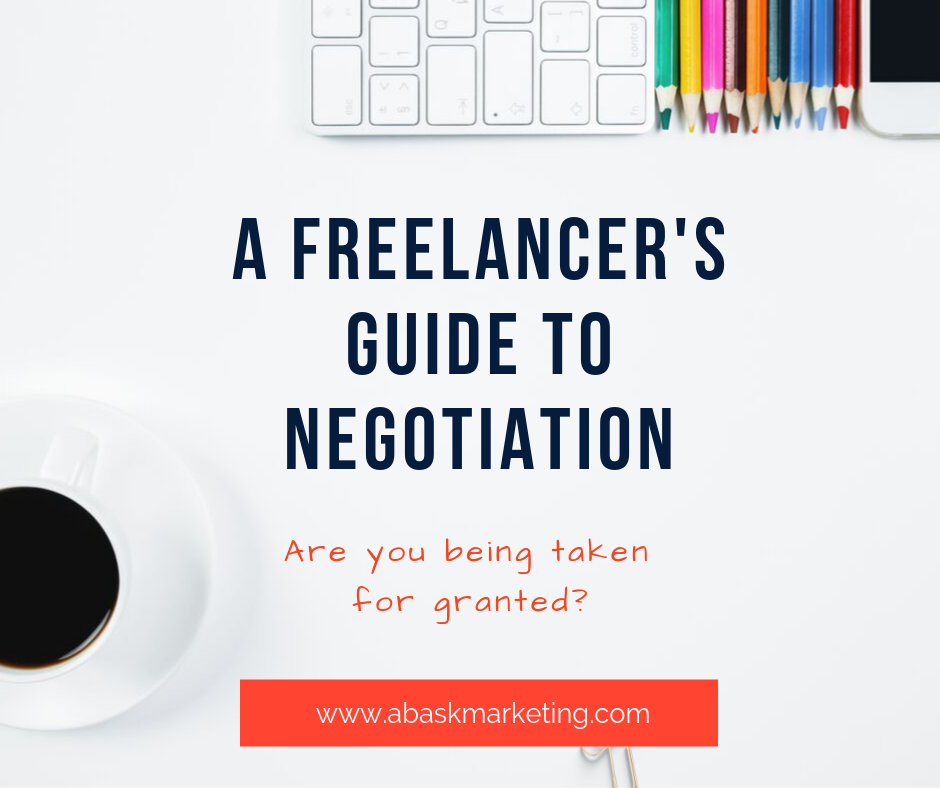Breakthrough for freelancers: Shine a spotlight on your rates!

What to charge for freelance services
This is a hot topic in the freelance and contractor world. Unless you have a specific product, you are ultimately selling your own services. How much is your time worth?
And here’s the tough answer: nobody has a definitive answer for what you should charge except you, but today I will go through my fees and how you might be able to figure out your own worth based on my calculations. Yep. You read that right – I am actually publishing my rate card for you to see! But before you start scrolling to that part of the article, let me help you figure out how to price your services.
Pricing Methods
There are different ways of charging for your services and I am speaking as an experienced freelance copywriter, but this also applies to designers and developers as well as a few other solopreneur type jobs, such as coaching (career coaching, life coaching, health coaches, etc.)
 Project-based payments
Project-based payments
This is where the client tells you what they want and you tell them how much it will cost. Sounds easy, right? It can be. It’s easy to determine the end goal, the start date, and the deadline. This is as close to selling a product as copywriting can be.
“I’d like an ebook, please.”
“Yes ma’am, that’ll be $320.”
Done.
The hard part is figuring out the cost – but we’ll get to that in just a minute.
To determine if this is the way you should bill, ask yourself these questions. If you can answer them, you can use this method.
1. What is the end product?
2. What is the deadline?
3. How long do you think this will take you?
4. Is anyone else involved? If so, do you completely trust that they will stick to their commitment?
5. How many edits does the client get?
6. How many meetings will you need to complete the project?
7. Do you have a signed contract and a deposit?
8. When will you get paid?
 Hourly-based work
Hourly-based work
Hourly-based work is very common in all kinds of consulting businesses. The upside is that it’s an easy sell. Many businesses hiring you for your services will say yes to an hourly rate because it sounds like a low number.
“What’s your hourly rate?”
“$60/hour.”
“Ok, that sounds reasonable. Let’s do it.”
Three months later:
“I got a bill for $600 for the work you did last month. That’s outrageous!””
“But we agreed on $60/hour.”
“I didn’t know a blog post would be 10 hours of work.”
Now both client and copywriter are pissed because they feel slighted. Not knowing how long a project could cause problems and if you do know how long a project would take, why wouldn’t you choose the project rate?
To avoid this, make sure you give an estimate of how long you think a task will take. Next, give them a heads-up option. If I have to add a task to an assignment, I will bill hourly and I tell my clients that I will give them a heads-up at the five-hour mark. That way they can decide whether to stop or keep going (and I put a warning in the email: “I will be stopping all work until I get approval from you.”)
Hourly work is tough. You have to monitor your time carefully, you feel guilty for taking too long and you may fall into a trap of endless paperwork, reporting hours and then validating yourself over every ten-minute task. Trust me, that’s soul-sucking stuff. But, sometimes hourly is the way you have to go to get a foot in the door or complete an extra task for a great client.
 Word-based payments
Word-based payments
This explanation won’t take long.
Don’t do it.
Don’t ever do it.
If you are a freelance writer working for magazines, you are the only exception to this rule. Magazines have been paying this way forever and the benefit of being published in a good magazine will usually outweigh the downfall of getting paid close to nothing.
If you are a copywriter and someone asks you how much you charge per word, you can either tell them some outrageous number or feel free to tell them that you are not at that point in your career anymore. Preferably, the second with the sneer you used when you were in high school (hair flip is optional). Don’t feel guilty, this is the realm of soul-sucking, content-churning websites that hire writers with no experience (or writers overseas that are willing to work for pennies an hour.) These sites won’t even let you claim your own work, so you are underpaid and not recognized. Not worth it!
I was recently introduced to a designer that was “always looking for good copywriters.” She asked me how much I charged per word and I realized why she needed a constant search for copywriters.
Lady, you can’t get good writers because good writers don’t play like that, homie!
 Retainer-based payments
Retainer-based payments
Retainers are a goldmine to some people. And there are definite benefits to a retainer and definite downsides. With a retainer, you are basically on call. You charge a monthly rate and the client has access to you whenever they want within reason.
My retainers include a certain amount of hours, like 12 hours a month, and anything over is billed hourly. Anything less is billed at 12 hours a month. The client gets a reduced charge this way and you get a guarantee of payment every month.
Let me give you an example:
“We have an ongoing need for a copywriter but don’t have the budget for someone in-house.”
“Ok, I can give you a retainer of a minimum 10 hours a month at $60/hour. Anything over will be my regular rate of $120.”
“That sounds good. What if we only use 6 hours one month?”
“You still pay $600 for the month, but that is still cheaper than the hourly rate and a lot cheaper than hiring someone on staff full time”
“That makes sense. We’ll do it.”
Other agencies (especially PR agencies), charge a flat fee for on-call services and then charge hourly for work completed. So, in that case, the client might pay $600/ month for someone to be on call (someone who knows the client’s background, style, and voice) and then $125/hour for every task completed.
I find retainers to be the perfect situation ONLY if they are set up correctly.
The downsides of a retainer are
• you are still monitoring your hours.
• The goals tend to be a bit vaguer leaving client feeling uneasy and copywriter feeling guilty.
• You can be on a constant pitch and chase. “How about if I write this for you?” “I’d love to get on your calendar to discuss the copy deck. Are you available Monday? Tuesday? Wednesday? Hello? Bueller?” This is especially true if you are not working with the business owner but a lower level employee. They have no stake in the game, so your failure is no big whoop to them.
Ways to make a retainer more successful:
1. Never send a client an hourly report unless you are asked (or if you choose the second type of retainer set up). You don’t want to get into doing more work than you have to. But track your hours anyway. Otherwise, how will you know if you are spending more time than you thought?
2. Set monthly meetings with monthly goals. Be realistic about deadlines. If you are reliant on someone for feedback, be sure that they set their own deadline. I use webinar meetings for this as my clients are all over the place, and I can record the meetings and store them for everybody in Trello. Just be sure to let everyone know they are being recorded.
3. Work with owners whenever possible. Otherwise, meet in person or via webcam and schmooze your way into their hearts. Don’t be afraid to shell out money for lunch or coffee. You want them to want you to succeed. I think that’s what I meant.
4. Find the right tools to work together and stick with them.
How to figure out your own worth
Here’s where the truth gets a little wobbly. There is no hard and fast rule on pricing and I would be willing to bet that most copywriters will admit to a little guesswork when it comes to pricing for a new client.
Here’s how I figured it out when I first started.
1. I broke down how much I made at my old job per hour
To do this, I took my gross salary (before taxes and health care). I divided this by 52 and then by 40. I did not take out the taxes or healthcare and other benefits because I still need to pay myself those goodies one way or another. The number I was left with was my hourly salary.
2. I laid out my expenses and added them to the hourly rate (again breaking them into hourly numbers)
3. I researched as much as possible to see what the standard rates were. I compared my experience and the value I can bring to the standard. Then I reassessed my hourly salary and found my number was a little higher, especially as I was new to freelancing.
4. Then, I started pounding the pavement. When I bid on my first job, I used my hourly rate as a starting point (if it’s a retainer, lower the rate a little for your retainer and up it a little for the hourly rate to cover additional hours outside the retainer.)
If a client jumped at my number and said, “Sure! Sounds good!” without negotiation or hesitation, I knew I had come in too low. Next time, I bumped it up a little.
And if I found people not signing contracts with me at that number, I lowered it a little.
That was 2010. Today, I know our standard agency hourly rates (and now I have more steady overhead numbers to factor in), but if a client seems very easy going, I’m likely to lower the rate a little because I prefer to work with people that are easy going and humble. If the client seems like a royal pain, or if they tell me they are slow to pay (no joke, my newest client told me that in the first meeting), then I ‘m likely to add on a pita fee (pain in the arse fee.) If the job sounds fun and I can’t wait to get started, it’ll be cheaper. If the job is super technical and my head hurts from the first meeting, then there will be an additional pain in the head fee. And that’s not just me, that’s all freelancers, solopreneurs, entrepreneurs, agencies, and consultants that I know.
The bottom line:
There is no hard and fast science to pricing your services and it will always fluctuate from day one to day 1000, but always keep in mind the following:
• You are only worth as much as you ask.
• Never ever quote a range. You say “between $500 and $1500.” Client hears “$500” (caveat: if you have no detail on the project, it’s ok to tell someone that the price starts at… because you should have some answer.)
• Give yourself a raise when business is booming and be ready to give special offers when times are slow.
• Figure out if your business is seasonal as quickly as possible. Store nuts for winter, my friends!
Should your rates be on your website?
Pricing for copywriters, designers, solopreneurs, and consultants are tough because very few people share them. I have very recently changed my mind on the answer after being cornered in two different networking events by people demanding my prices.
I didn’t use to publish my rates because I felt it was too restrictive. But now I realize that restriction can be good!
You see, if my rates are too high for small businesses and entrepreneurs (which they usually are), I have other ways to help them, such as downloads and classes (selfish plug: our 2018 catalog of classes coming soon!) The time wasted on going back and forth trying to find the right project is time wasted for both parties and it can be very demeaning for either party! If they cannot afford your prices, they will be embarrassed and maybe shocked at the cost. Then you feel like they might be questioning your worth.
With a rate card, it’s quick and easy. They see how much it costs, nobody has to be embarrassed and time is not a’wastin’!
And, finally, here it is… for your perusal – my rate card: https://abaskmarketing.com/ratecard
If you have a different way of dealing with pricing or contracts, I would love to hear about it. I’m always looking for the perfect solution, so please share away I the comments below.
THE END
but it doesn’t have to be…
Related Articles:
How to Travel and Work From Anywhere
A business owner or freelancer knows how hard it is to travel and work from anywhere. Here are strategies you can implement.
Every writer should be in a mastermind group they love
Imagine having your own group of like-minded people. All at different stages, but basically aiming for the same target. All willing to listen and help each other. AND the best part of all is that none of them are pushing a course or making crazy promises to get you into the group. That, my friends, is a mastermind.
DO YOU BACK DOWN TOO EASILY? A FREELANCER’S GUIDE TO NEGOTIATION
This week I was asked to fly across the country for a one-day meeting. I hesitatingly agreed. Meeting in person has its benefits, but flying across the country for one meeting means leaving my other clients hanging and my employees scrambling. On top of...
LEAVE A COMMENT
We’d love to hear from you.













0 Comments